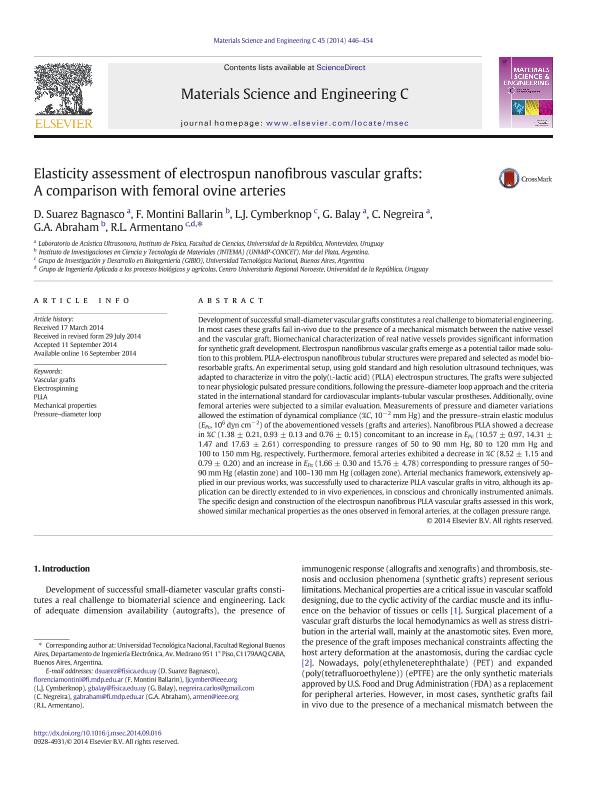Mostrar el registro sencillo del ítem
dc.contributor.author
Suarez Bagnasco, D.
dc.contributor.author
Montini Ballarin, Florencia

dc.contributor.author
Cymberknop, Leandro Javier

dc.contributor.author
Balay, G.
dc.contributor.author
Negreira, C.
dc.contributor.author
Abraham, Gustavo Abel

dc.contributor.author
Armentano, Ricardo Luis

dc.date.available
2017-12-04T14:36:33Z
dc.date.issued
2014-12-16
dc.identifier.citation
Suarez Bagnasco, D.; Montini Ballarin, Florencia; Cymberknop, Leandro Javier; Balay, G.; Negreira, C.; et al.; Elasticity assessment of electrospun nanofibrous vascular grafts: a comparison with femoral ovine arteries; Elsevier; Materials Science and Engineering: C; 45; 16-12-2014; 446-454
dc.identifier.issn
0928-4931
dc.identifier.uri
http://hdl.handle.net/11336/29530
dc.description.abstract
Development of successful small-diameter vascular grafts constitutes a real challenge to biomaterial engineering. In most cases these grafts fail in-vivo due to the presence of a mechanical mismatch between the native vessel and the vascular graft. Biomechanical characterization of real native vessels provides significant information for synthetic grafts development. Electrospun nanofibrous vascular grafts emerge as a potential tailor made solution to this problem. PLLA-electrospun nanofibrous tubular structures were prepared and selected as model bioresorbable grafts. An experimental setup, using gold standard and high resolution ultrasound techniques, was adapted to characterize in vitro the Poly(L-lactic acid) (PLLA) electrospun structures. The grafts were subjected to near physiologic pulsated pressure conditions, following the pressure-diameter loop approach and the criteria stated in the international standard for cardiovascular implants-tubular vascular prostheses. Additionally, ovine femoral arteries were subjected to a similar evaluation. Measurements of pressure and diameter variations allowed the estimation of dynamical compliance (C%, 10-2 mmHg) and the pressure-strain elastic modulus (EPe, 106 dyn cm-2) of the abovementioned vessels (grafts and arteries). Nanofibrous PLLA showed a decrease in %C (1.38 ± 0.21, 0.93 ± 0.13 and 0.76 ± 0.15) concomitant to an increase in EPe (10.57 ± 0.97, 14.31 ± 1.47 and 17.63 ± 2.61) corresponding to pressure ranges of 50 to 90 mmHg, 80 to 120 mmHg and 100 to 150 mmHg, respectively. Furthermore, femoral arteries exhibited a decrease in %C (8.52 ± 1.15 and 0.79 ± 0.20) and an increase in EPe (1.66 ± 0.30 and 15.76 ± 4.78) corresponding to pressure ranges of 50-90 mmHg (elastin zone) and 100-130 mmHg (collagen zone). Arterial mechanics framework, extensively applied in our previous works, was successfully used to characterize PLLA vascular grafts in vitro, although its application can be directly extended to in vivo experiences, in conscious and chronically instrumented animals. The specific design and construction of the electrospun nanofibrous PLLA vascular grafts assessed in this work, showed similar mechanical properties as the ones observed in femoral arteries, at the collagen pressure range.
dc.format
application/pdf
dc.language.iso
eng
dc.publisher
Elsevier

dc.rights
info:eu-repo/semantics/openAccess
dc.rights.uri
https://creativecommons.org/licenses/by-nc-sa/2.5/ar/
dc.subject
Vascular Grafts
dc.subject
Electrospinning
dc.subject
Plla
dc.subject
Mechanical Properties
dc.subject
Pressure Diameter Loop
dc.subject.classification
Ingeniería de Sistemas y Comunicaciones

dc.subject.classification
Ingeniería Eléctrica, Ingeniería Electrónica e Ingeniería de la Información

dc.subject.classification
INGENIERÍAS Y TECNOLOGÍAS

dc.subject.classification
Recubrimientos y Películas

dc.subject.classification
Ingeniería de los Materiales

dc.subject.classification
INGENIERÍAS Y TECNOLOGÍAS

dc.subject.classification
Biotecnología Industrial

dc.subject.classification
Biotecnología Industrial

dc.subject.classification
INGENIERÍAS Y TECNOLOGÍAS

dc.title
Elasticity assessment of electrospun nanofibrous vascular grafts: a comparison with femoral ovine arteries
dc.type
info:eu-repo/semantics/article
dc.type
info:ar-repo/semantics/artículo
dc.type
info:eu-repo/semantics/publishedVersion
dc.date.updated
2017-11-10T15:39:50Z
dc.journal.volume
45
dc.journal.pagination
446-454
dc.journal.pais
Países Bajos

dc.journal.ciudad
Amsterdam
dc.description.fil
Fil: Suarez Bagnasco, D.. Universidad de la República. Facultad de Ciencias; Uruguay
dc.description.fil
Fil: Montini Ballarin, Florencia. Consejo Nacional de Investigaciones Científicas y Técnicas. Centro Científico Tecnológico Conicet - Mar del Plata. Instituto de Investigaciones en Ciencia y Tecnología de Materiales. Universidad Nacional de Mar del Plata. Facultad de Ingeniería. Instituto de Investigaciones en Ciencia y Tecnología de Materiales; Argentina
dc.description.fil
Fil: Cymberknop, Leandro Javier. Universidad Tecnológica Nacional. Facultad Regional Buenos Aires; Argentina
dc.description.fil
Fil: Balay, G.. Universidad de la República. Facultad de Ciencias; Uruguay
dc.description.fil
Fil: Negreira, C.. Universidad de la República. Facultad de Ciencias; Uruguay
dc.description.fil
Fil: Abraham, Gustavo Abel. Consejo Nacional de Investigaciones Científicas y Técnicas. Centro Científico Tecnológico Conicet - Mar del Plata. Instituto de Investigaciones en Ciencia y Tecnología de Materiales. Universidad Nacional de Mar del Plata. Facultad de Ingeniería. Instituto de Investigaciones en Ciencia y Tecnología de Materiales; Argentina
dc.description.fil
Fil: Armentano, Ricardo Luis. Universidad Tecnológica Nacional; Argentina. Universidad de la República; Uruguay. Consejo Nacional de Investigaciones Científicas y Técnicas; Argentina
dc.journal.title
Materials Science and Engineering: C

dc.relation.alternativeid
info:eu-repo/semantics/altIdentifier/url/http://www.sciencedirect.com/science/article/pii/S0928493114005864
dc.relation.alternativeid
info:eu-repo/semantics/altIdentifier/doi/http://dx.doi.org/10.1016/j.msec.2014.09.016
Archivos asociados
